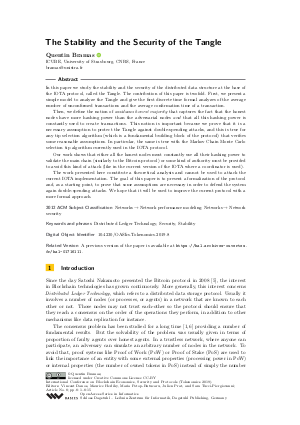The Stability and the Security of the Tangle
Author
Quentin Bramas 
-
Part of:
Volume:
International Conference on Blockchain Economics, Security and Protocols (Tokenomics 2019)
Part of: Series: Open Access Series in Informatics (OASIcs)
Part of: Conference: International Conference on Blockchain Economics, Security and Protocols (Tokenomics) - License:
 Creative Commons Attribution 3.0 Unported license
Creative Commons Attribution 3.0 Unported license
- Publication Date: 2020-03-17
File

PDF
OASIcs.Tokenomics.2019.8.pdf
- Filesize: 474 kB
- 15 pages
Document Identifiers
Related Versions
-
A previous version of the paper is available at https://hal.archives-ouvertes.fr/hal-01716111.
Subject Classification
ACM Subject Classification
- Networks → Network performance modeling
- Networks → Network security
Keywords
- Distributed Ledger Technology
- Security
- Stability
Metrics
- Access Statistics
-
Total Accesses (updated on a weekly basis)
0Document
0Metadata
Abstract
In this paper we study the stability and the security of the distributed data structure at the base of the IOTA protocol, called the Tangle. The contribution of this paper is twofold. First, we present a simple model to analyze the Tangle and give the first discrete time formal analyzes of the average number of unconfirmed transactions and the average confirmation time of a transaction. Then, we define the notion of assiduous honest majority that captures the fact that the honest nodes have more hashing power than the adversarial nodes and that all this hashing power is constantly used to create transactions. This notion is important because we prove that it is a necessary assumption to protect the Tangle against double-spending attacks, and this is true for any tip selection algorithm (which is a fundamental building block of the protocol) that verifies some reasonable assumptions. In particular, the same is true with the Markov Chain Monte Carlo selection tip algorithm currently used in the IOTA protocol. Our work shows that either all the honest nodes must constantly use all their hashing power to validate the main chain (similarly to the Bitcoin protocol) or some kind of authority must be provided to avoid this kind of attack (like in the current version of the IOTA where a coordinator is used). The work presented here constitute a theoretical analysis and cannot be used to attack the current IOTA implementation. The goal of this paper is to present a formalization of the protocol and, as a starting point, to prove that some assumptions are necessary in order to defend the system again double-spending attacks. We hope that it will be used to improve the current protocol with a more formal approach.
Cite As Get BibTex
Quentin Bramas. The Stability and the Security of the Tangle. In International Conference on Blockchain Economics, Security and Protocols (Tokenomics 2019). Open Access Series in Informatics (OASIcs), Volume 71, pp. 8:1-8:15, Schloss Dagstuhl – Leibniz-Zentrum für Informatik (2020)
https://doi.org/10.4230/OASIcs.Tokenomics.2019.8
BibTex
@InProceedings{bramas:OASIcs.Tokenomics.2019.8,
author = {Bramas, Quentin},
title = {{The Stability and the Security of the Tangle}},
booktitle = {International Conference on Blockchain Economics, Security and Protocols (Tokenomics 2019)},
pages = {8:1--8:15},
series = {Open Access Series in Informatics (OASIcs)},
ISBN = {978-3-95977-108-5},
ISSN = {2190-6807},
year = {2020},
volume = {71},
editor = {Danos, Vincent and Herlihy, Maurice and Potop-Butucaru, Maria and Prat, Julien and Tucci-Piergiovanni, Sara},
publisher = {Schloss Dagstuhl -- Leibniz-Zentrum f{\"u}r Informatik},
address = {Dagstuhl, Germany},
URL = {https://drops.dagstuhl.de/entities/document/10.4230/OASIcs.Tokenomics.2019.8},
URN = {urn:nbn:de:0030-drops-119725},
doi = {10.4230/OASIcs.Tokenomics.2019.8},
annote = {Keywords: Distributed Ledger Technology, Security, Stability}
}
Author Details
References
-
Michael J Fischer, Nancy A Lynch, and Michael S Paterson. Impossibility of distributed consensus with one faulty process. Journal of the ACM (JACM), 32(2):374-382, 1985.

-
Juan Garay, Aggelos Kiayias, and Nikos Leonardos. The bitcoin backbone protocol: Analysis and applications. In Annual International Conference on the Theory and Applications of Cryptographic Techniques, pages 281-310. Springer, 2015.

- B. Kuśmierz. The first glance at the simulation of the Tangle: discrete model, 2016. URL: http://iota.org/simulation_tangle-preview.pdf.
-
Michael Mitzenmacher and Eli Upfal. Probability and computing: Randomized algorithms and probabilistic analysis. Cambridge university press, 2005.

- Satoshi Nakamoto. Bitcoin: A peer-to-peer electronic cash system, 2008. URL: https://bitcoin.org/bitcoin.pdf.
- M. Pease, R. Shostak, and L. Lamport. Reaching Agreement in the Presence of Faults. J. ACM, 27(2):228-234, April 1980. URL: https://doi.org/10.1145/322186.322188.
- S Popov. The tangle. White paper, 2016. URL: https://iota.org/IOTA_Whitepaper.pdf.
- Serguei Popov, Olivia Saa, and Paulo Finardi. Equilibria in the Tangle. arXiv preprint, 2017. URL: http://arxiv.org/abs/1712.05385.
